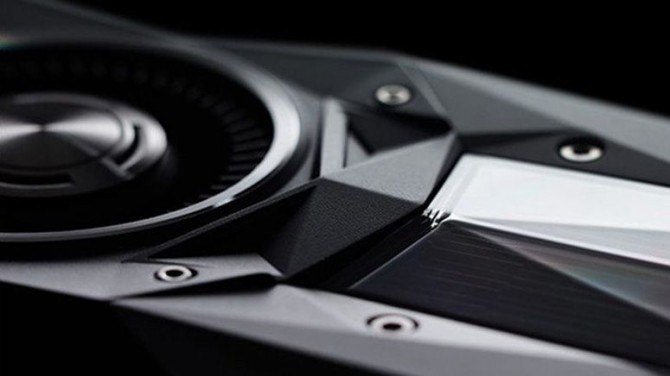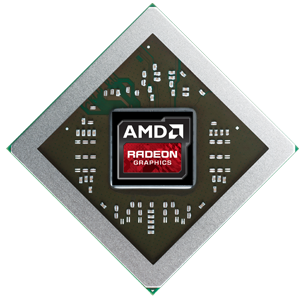Which GPU is Right For You?
If a laptop's brain is the CPU, then consider the GPU the occipital lobe. Responsible for rendering images, video and animations in either 2D or 3D for the display, the chip performs rapid mathematical computations, freeing up the processor for other tasks. Where a CPU consists of a few cores focused on sequential serial processing, GPUs pack thousands of smaller cores designed for multitasking.

While your Intel Core i7 CPU can render graphics, it'll do so at a much slower rate than a GPU. In fact, GPUs have so much power that some programs tap them into service to help out the CPU on non-graphics tasks, which drastically increases speed and performance. That's why every laptop, whether it's designed for business, gaming or education, has some sort of GPU under the hood.
Now that you have a general understanding of what a GPU is and why you need one in your laptop, we have to ask: Which chip is right for you? Do you yearn for the face-melting frame rates delivered by Nvidia's recently launched GeForce RTX 2080 GPU? Or do you or want something more conservative, like Intel's integrated HD Graphics? This guide will walk you through the ins and outs of choosing the right GPU for your needs.
GPU Cheat Sheet
There are a lot of different GPUs out there, and we cover all of them. But if you want the TL;DR version of what the GPU world has to offer, here's a quick chart to guide you.
| Purpose | Recommended GPUs | Sample SKUs |
| Gaming / Multimedia | Nvidia GeForce RTX 20-series, AMD RX 400-series, Intel Iris Plus | Nvidia RTX 2080, AMD RX 480, Iris Plus 650 |
| Workstation | Nvidia Quadro, AMD Radeon Pro, Intel HD Graphics | Nvidia Quadro P5200, Radeon Pro WX 7100, Intel HD Graphics P630 |
| Mainstream/Everyday Productivity/Super Thin | Intel UHD Graphics, Intel Iris Plus | Intel UHD Graphics 630, Intel Iris Plus 640 |
| Budget Gaming | Nvidia GeForce GTX 10-series | Nvidia GeForce GTX 1050 |
Discrete or Integrated: What's the Difference?
There are two main types of graphics processor: integrated and discrete. As the name suggests, integrated graphics means that the GPU is integrated onto the CPU die and shares memory with the processor. Discrete chips are contained on their own card and come equipped with their own memory, called video memory or VRAM, leaving your system RAM untouched.
If you want the best possible graphics performance, discrete graphics chips beat integrated GPUs every time. The amount of VRAM allocated to current GPUs ranges between 2 and 8 GBs (we have a short guide on how to check your VRAM). Since integrated chips rely on the system RAM, they don't have the computing power of their discrete counterparts. That's something to keep in mind if you're planning to play one of your favorite PC titles on the highest settings.
What's in a Name (and Number)?
Quadro, GeForce, Radeon, HD Graphics, Iris - who can keep up with all these names? While I don't expect you to know the backstory behind each naming convention, it wouldn't hurt to know which brand of GPU handles what. For instance, Nvidia's Quadro line refers to the company's workstation-class video cards, while GeForce GTX refers to the mainstream/enthusiast line of gaming/multimedia GPUs that the majority of fans are familiar with.
Stay in the know with Laptop Mag
Get our in-depth reviews, helpful tips, great deals, and the biggest news stories delivered to your inbox.

AMD GPUs typically carry the Radeon moniker followed by a prefix, which designates the chip's performance. For instance, the R9 suffix represents AMD's high-performance line, while R7 is more midtier. R5 and R3 refer to the company's entry-level chips. The "M" placed before the second batch of numbers represents mobility and designates that the chip is for mobile devices, such as laptops and tablets. However, for the 400 series, the current generation, AMD has ditched the M designation and labeled every chip in the lineup RX regardless of performance capability.
The number directly after represents the generation (the higher the number, the newer the generation). The next digit corresponds to the performance tier with the higher numbers representing higher performance levels. The last number in the series represents the revision number. And if you see an X at the end, it means that you've got the faster version of the original GPU.
Unlike their CPUs, Intel GPUs don't follow the serial-number-naming convention. That means that even though the company has worked its way up to it 8th-generation Kaby Lake processors, the corresponding integrated GPUs are rocking model numbers in the 600s (example: Intel HD Graphics 630) rather than 700. The more powerful the chip, the higher the number.
GPU Specs: Cores, Base Clock and Memory Speed
Just like your laptop, your GPU comes with a set of specs. But before you get lost in a world of techie jargon, here are some of the more important ones to keep in mind.
Memory Bandwidth: One of the main things to consider when choosing a GPU, memory bandwidth measures the rate that data can be read or stored into the VRAM by the video card, which is measured by gigabyte per second (GB/s). A video card with high memory bandwidth can render images faster and at higher quality. But keep in mind that bandwidth is affected by memory clock speed, type and width.
Base Clock: This is pretty straightforward. Measured in megahertz (MHz), the base clock is your video card's speed in non-stress testing applications. This is the absolute minimum speed your GPU will run at under non-stressful applications.
Boost Clock: Boost clock is the minimum amount of boost speed you can get from your GPU. However, depending on your system's power and thermals, you can raise the boost speed past the factory set rate.
Memory Speed: This is your VRAM speed, which is measured in MHz (megahertz) and determines the frequency of data passed between the VRAM and GPU.
Nvidia—CUDA Cores: CUDA (Compute Unified Device Architecture) is Nvidia's programming language that can control the GPU in specific ways to perform tasks with greater speed and efficiency. Thousands of Cores can be packed onto a chip, which is necessary for all those mathematical computations that render all your shiny graphics. That means that the more CUDA Cores a chip has, the more powerful it is.
AMD—Stream Processors: Responsible for processing all data flowing in and out of the GPU, Stream Processors are AMD's answer to CUDA Cores. Stream Processors perform mathematical computations needed for rendering graphics. Similar to CUDA Cores, the more you have, the more powerful the chip is.
Generational Gap:
Similar to Intel, every year or two Nvidia launches a new GPU generation that's faster, more powerful and more battery-friendly than the previous line. This time around, Nvidia made the jump from its Pascal architecture to Turing while the Intel-powered chips moved from Skylake to Kaby Lake. AMD is currently on the Polaris-based Radeon RX460 and R-9 series of its mobile GPUs, leaving behind the M300 series.
| Major Nvidia GPU Platforms | ||||
| Generation | Code Name | Launch Year | CUDA Cores (Minimum) | CUDA Cores (Maximum) |
| 10th | Pascal | 2016 | 640 | 2560 |
| 9th | Maxwell | 2015 | 640 | 1536 |
| 8th | 1st-gen Maxwell | 2014 | 640 | 1536 |
| Major AMD GPU Platforms | ||||
| Generation | Code Name | Launch Year | Stream Processors (Min) | Stream Processors (Max) |
| 4th | Polaris | 2016 | 320 | 2048 |
| 3rd | Tonga | 2015 | 320 | 640 |
| 2nd | Neptune | 2014 | 320 | 1280 |
| Major Intel CPU Platforms | ||||
| Generation | Code Name | Launch Year | Base Clock (Min) | Turbo Clock (Max) |
| 7th | Kaby Lake | 2016 | 2.3 GHz | 4 GHz |
| 6th | Skylake | 2015 | 1.92 GHz | 3.5 GHz |
| 5th | Broadwell | 2014 | 2 GHz | 3.6 GHz |
GPU Lines
Nvidia Quadro: Exclusive to Workstations
Good For: Engineering, Game Design, VR and Research
Bad For: Affordability, Battery Life and Weight
Nvidia's Quadro line can be found in most mobile workstations doing the heavy lifting for programs like AutoCad or the Unreal 4 Engine. According to the company, the latest generation of Quadro GPUs features up to three times the performance and twice the computing power and memory of its predecessors, rivaling their desktop counterparts. Quadro is the way to go if you're looking to design the world's next tallest skyscraper, run the human genome or make the next blockbuster film.
The latest Quadro GPUs, with the exception of the Quadro P3000, are VR-ready. They are also built on Pascal architecture, which features more CUDA cores than their Maxwell counterparts.
| Common Nvidia Quadro GPUs | |||||
| Name | CUDA Cores | VRAM | Memory Bandwidth | VR | 4K |
| Quadro P5000 | 2048 | 16GB | 192 GBps | Yes | Yes |
| Quadro P4000 | 1792 | 8GB | 192 GBps | Yes | Yes |
| Quadro P3000 | 1280 | 6GB | 168 GBps | No | Yes |
Nvidia GeForce: One-Stop Fragging Shop
Good For: Gaming, VR and Multimedia
Bad For: Gamers on a tight budget
Whether you're a casual gamer or a hardcore one, Nvidia's GeForce GTX line has a GPU that can tickle your gaming fancy. With the exception of the new entry-level 1050 and 1050 Ti chips, all of the 10-series GPUs are VR-ready, which allows laptops as small as the Alienware 13 OLED or the Razer Blade to power a Rift or Vive headset. But if you want to think big, there are the absolutely massive MSI GT83VR Titan SLI and Origin PC Eon17-SLX 10 Series laptops, which feature 18.4-inch displays and dual GTX 1080s in SLI configuration.
But just when you thought mobile Nvidia GPUs couldn't get any more powerful, the company goes and announces the new GTX 1080 Ti. Available for $699, Nvidia claims that the new Ti will have a 35-percent performance increase over the regular 1080. That's in large part to the 1.6-GHz clock book, 3,584 CUDA cores, 12 billion transistors and a whopping 11GB of video memory. No word on when 1080 Ti-laden laptops will be arriving on our doorstep, but when they do, expect buttery-smooth, lightning-fast frame rates.
| Common Nvidia GeForce GTX GPUs | |||||
| Name | CUDA Cores | Max VRAM | Memory Bandwidth | VR | 4K |
| GTX 1080 | 2560 | 8GB | 320 GBps | Yes | Yes |
| GTX 1070 | 2048 | 8GB | 256 GBps | Yes | Yes |
| GTX 1060 | 1280 | 6GB | 192 GBps | Yes | Yes |
| GTX 1050 Ti | 768 | 4GB | 192 GBps | No* | Yes |
| GTX 1050 | 640 | 4GB | 112 GBps | No | Yes |
*The 1050 Ti is currently not VR-ready, but Oculus is working on its Asynchronous Space Warp technology to grant it Oculus-Ready certification.
AMD Radeon RX: Affordable and Discrete
Good For: Affordability, Performance and Efficiency
Bad For: Gamers looking for a complete VR solution.
Although you'd typically find an AMD GPU powering some hulking gaming desktop, the company also has a presence in mobile systems, like the upcoming refresh for the Alienware 17. The current crop of AMD mobile GPUs are capable of putting up big numbers on traditional gaming fare, such as Rise of the Tomb Raider or Deus Ex: Mankind Divided. Although the RX 480 is cleared to support both Oculus Rift and HTC Vive, you'll have to research whether the other cards in the series are Oculus or VR-ready.
| Common AMD GPUs | |||||
| Name | Steam Processors | VRAM | Memory Bandwidth | VR | 4K |
| RX 480 | 2048 | 8GB | 256 GBps | Yes | Yes |
| RX 470 | 896 | 4GB | 211 GBps | Yes* | Yes |
| RX 460 | 768 | 4GB | 112 GBps | No | Yes |
*The AMD RX 470 GPUs meets the minimum requirement to be Oculus-certified. However, keep in mind that Oculus Ready and VR-Ready are two different things. Using its Asynchronous Space Warp technology, the company has been able to welcome lower power cards into the Oculus mix, but that doesn't apply for the HTC Vive.
AMD recently announced a new laptop GPU named Vega Mobile. Details are still pretty scarce, but there are a few tidbits. Designed for thin-and-light laptops, Vega will be in direct competition with Nvidia's Max-Q GPUs. In terms of power, AMD claims the discrete chip will deliver high frame rates on demanding AAA titles without requiring too much power. The company says Vega will have a low power usage and a 1.7 millimeter Z- height which is about half as tall as its RX 580 mobile GPU. Vega will also utilize 2nd-generation High Bandwidth Memory (HBM2).
Intel Iris Plus Graphics: Closing the Gap
Good For: Midlevel Gaming
Bad For: Gamers and creative professionals looking for top-level graphics performance.
Iris Plus is Intel's attempt to close the gap between integrated and discrete graphics. Targeting the casual and midtier gamers, Iris Pro chips will allow you to play League of Legends at a solid, stable frame rate. However, you're most likely to find Iris Plus GPUs teaming with a discrete chip in a powerful workstation, helping you build fantastical worlds or plans for very real skyscrapers.
| Common Intel Iris GPUs (7th Gen CPUs) | ||||
| Name | Max VRAM | Memory Bandwidth | VR | 4K |
| Iris Plus Graphics 650 | 32GB | 34.1 GBps | No | Yes |
| Iris Plus Graphics 640 | 32GB | 34.1 GBps | No | Yes |
Intel HD Graphics: Watch Some Videos, Play Some WoW
Good For: Affordability, Portability, Versatility
Bad For: Performance
From ultraportables like the Dell XPS 13 2-in-1 to business laptops like the HP Elitebook 1030 G1 and everywhere in between, you're likely to find an Intel HD Graphics chip beneath the hood. Sharing memory with its Intel CPU, iterations of this chip have been reliably streaming videos and running less-taxing games without a hitch. You might even find an integrated GPU with a discrete chip, alternating depending on the task. But when push comes to shove, you'll want to look at a much more powerful chip if you want smooth frame rates when gaming, especially at those higher settings.
| Common Intel HD Graphics (7th Gen CPUs) | ||||
| Name | Max VRAM | Memory Bandwidth | VR | 4K |
| HD Graphics P630 | 64GB | 34.1 GBps | No | Yes |
| HD Graphics 630 | 64GB | 34.1 GBps | No | Yes |
| HD Graphics 620 | 32GB | 34.1 GBps | No | Yes |
| HD Graphics 615 | 16GB | 29.8 GBps | No | Yes |
| HD Graphics 610 | 64GB | 34.1 GBps | No | Yes |
More than a GPU
While it's important to consider the GPU if you're on the hunt for a gaming or multimedia laptop, don't gloss over other components like the CPU. It won't do you any good to buy a laptop with top-of-the-line Nvidia graphics and a midtier Core i5 CPU. Other specs to take into consideration are the display, storage and RAM. And if you plan to use the notebook in your lap a lot, be sure to check its cooling solutions. In short, don't buy any laptop based on the GPU alone.

Sherri L. Smith has been cranking out product reviews for Laptopmag.com since 2011. In that time, she's reviewed more than her share of laptops, tablets, smartphones and everything in between. The resident gamer and audio junkie, Sherri was previously a managing editor for Black Web 2.0 and contributed to BET.Com and Popgadget.
